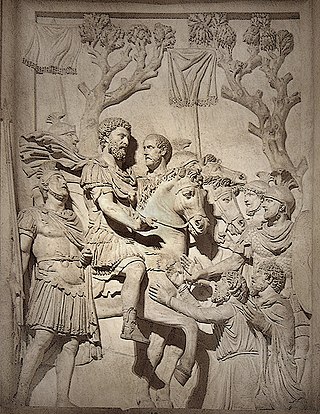Related Research Articles

Year 125 (CXXV) was a common year starting on Sunday of the Julian calendar. At the time, it was known as the Year of the Consulship of Paullinus and Titius. The denomination 125 for this year has been used since the early medieval period, when the Anno Domini calendar era became the prevalent method in Europe for naming years.
The 170s decade ran from January 1, 170, to December 31, 179.
The 190s decade ran from January 1, 190, to December 31, 199.
Year 113 (CXIII) was a common year starting on Saturday of the Julian calendar. At the time, it was known as the Year of the Consulship of Celsus and Crispinus. The denomination 113 for this year has been used since the early medieval period, when the Anno Domini calendar era became the prevalent method in Europe for naming years.
Year 165 (CLXV) was a common year starting on Monday of the Julian calendar. At the time, it was known as the Year of the Consulship of Orfitus and Pudens. The denomination 165 for this year has been used since the early medieval period, when the Anno Domini calendar era became the prevalent method in Europe for naming years.
Year 169 (CLXIX) was a common year starting on Saturday of the Julian calendar. At the time, it was known as the Year of the Consulship of Senecio and Apollinaris. The denomination 169 for this year has been used since the early medieval period, when the Anno Domini calendar era became the prevalent method in Europe for naming years.

Year 200 (CC) was a leap year starting on Tuesday of the Julian calendar. At the time, it was known as the Year of the Consulship of Severus and Victorinus. The denomination 200 for this year has been used since the early medieval period, when the Anno Domini calendar era became the prevalent method in Europe for naming years.

Year 233 (CCXXXIII) was a common year starting on Tuesday of the Julian calendar. At the time, it was known as the Year of the Consulship of Claudius and Paternus. The denomination 233 for this year has been used since the early medieval period, when the Anno Domini calendar era became the prevalent method in Europe for naming years.

Year 193 (CXCIII) was a common year starting on Monday of the Julian calendar. At the time, it was known as the Year of the Consulship of Sosius and Ericius. The denomination 193 for this year has been used since the early medieval period, when the Anno Domini calendar era became the prevalent method in Europe for naming years.
Year 197 (CXCVII) was a common year starting on Saturday of the Julian calendar. At the time, it was known as the Year of the Consulship of Magius and Rufinus. The denomination 197 for this year has been used since the early medieval period, when the Anno Domini calendar era became the prevalent method in Europe for naming years.
Severus is the name of various historical and fictional figures, including:
Year 210 (CCX) was a common year starting on Monday of the Julian calendar. At the time, it was known as the Year of the Consulship of Faustinus and Rufinus. The denomination 210 for this year has been used since the early medieval period, when the Anno Domini calendar era became the prevalent method in Europe for naming years.

The gens Claudia, sometimes written Clodia, was one of the most prominent patrician houses at ancient Rome. The gens traced its origin to the earliest days of the Roman Republic. The first of the Claudii to obtain the consulship was Appius Claudius Sabinus Regillensis, in 495 BC, and from that time its members frequently held the highest offices of the state, both under the Republic and in imperial times.

Tiberius Claudius Pompeianus was a politician and military commander during the 2nd century in the Roman Empire. A general under the Emperor Marcus Aurelius, Pompeianus distinguished himself during Rome's wars against the Parthians and the Marcomanni. He was a member of the imperial family due to his marriage to Lucilla, a daughter of Marcus Aurelius, and was a key figure during the emperor's reign. Pompeianus was offered the imperial throne three times, though he refused to claim the title for himself.

Pannonia Inferior, lit. Lower Pannonia, was a province of the Roman Empire. Its capital was Sirmium. It was one of the border provinces on the Danube. It was formed in the year 103 AD by Emperor Trajan who divided the former province of Pannonia into two parts: Pannonia Superior and Pannonia Inferior. The province included parts of present-day states of Hungary, Serbia, Croatia, and Bosnia and Herzegovina. The province was bordered to the east by a Sarmatian tribe—the Iazyges. Later, the Vandals appeared to the north-east.
Pompeianus may refer to:
Gnaeus Claudius Severus was a Roman senator and philosopher who lived in the Roman Empire during the 2nd century AD.
Marcus Ummidius Quadratus Annianus (138–182) was a Roman Senator and the nephew of the Emperor Marcus Aurelius. He was involved in an unsuccessful plot to assassinate his cousin the Emperor Commodus, which led to his execution afterwards.
Lucius Tiberius Claudius Pompeianus was a Roman senator and aristocrat of the 3rd century. He served as ordinary consul in 231 with Titus Flavius Sallustius Paelignianus as his colleague. His full name, previously known as Claudius Pompeianus, was only known after the discovery of a military diploma.
Lucius Aurelius Commodus Pompeianus was a Roman senator active in the early 3rd century. He was the son of Lucilla, the daughter of Marcus Aurelius, and her second husband Tiberius Claudius Pompeianus, a general active politically during the reigns of Emperors Commodus and Pertinax.
References
- ↑ Birley, Anthony (October 29, 2015). Septimius Severus : the African emperor (2nd ed.). ISBN 978-1-138-13416-4. OCLC 1062302222.